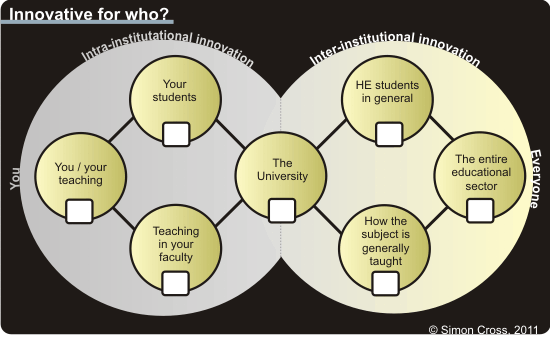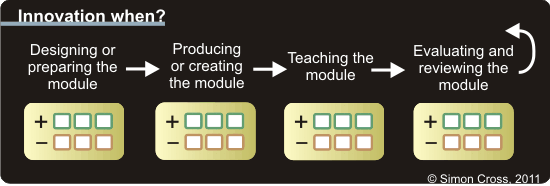Describing Teaching and Learning Innovation
February 14, 2012 Leave a comment
In this post I want to propose three ‘lenses’ that may be useful for describing and understanding the nature of a teaching and/or learning innovation. Innovation is certainly a prized commodity; deemed important enough to use to structure formal university module development and delivery processes, and to trade across and between practitioners and instititions. We also know that the question of innovation is likely to be an important consideration early on in the process of creating, designing and teaching a module or learning activities (and hopefully later on in the process also!).
So how do teachers talk about and represent their innovation? I have been involved in a couple of projects that sought to to capture innovation and, like similar attempts elsewhere, found it difficult to define what innovation was. The conclusion is, of course, that innovation is a nebulus term embracing everything from a paradigm shifting idea to borrowing one from a colleague and using in a class. Broadly speaking, one could suggest that innovation is anything that creates new possiblities by combining different knowledge sets that should result in positive change or added value. This expectation for there to be a positive result I think distinguishes innovation from other terms such ‘something different’ or ‘ something new’ and prevents it being abused to the extent that ‘being innovative’ becomes an aim in itself.
So if innovation can be many things, do we need to be more precise in how we talk about it? Perhaps, like for other aspects of learning design, it could be helpful to have some lenses with which to view, describe and define it. Fair enough, each lens will present only a partial representation, but together such views may help better understand the character of the innovation and to use and evaluate it effectively.
LENS 1: For who is the innovation innovative? Each individual, group or community who experiences the innovation will likely experience it differently: what is innovative for one module author may not be for their students who did it last year on a previous course; what is innovative for the general way a subject is taught may actually be ‘common practice’ for a ‘leading-edge’ faculty or university; what is innovative in one faculty may not be so across the univeristy.
So this first view represents seven key stakeholders in the educational innovation. When selecting these seven, I looked at the ways practitioners (in interviews or in written documents) spoke about who their innovation was innovative for. I also thought it important that the diagram be organised in terms of the scale/size of the group effected (note the progression from the individual (on the far left) to the entire sector (on the far right)). Arranging the representation in this way should make it is easier to see how extensive or local the innovation may be.
One way of using this view would be to determine how innovative the innovation is for each stakeholder and assign a score from 0-5. These scores could be written in the blanks provied. Scoring may be difficult, especially as one moves towards the right, however, such difficulties could spur further research or fact finding before a decision on the score can be made. And if it is impossible to determine a score, a question mark or cross could be inserted. Therefore, not only will this create a representation of comparatively how innovative it is for different groups, but also the boundaries to the claim that it innovative will have been defined.
LENS 2: Where is the innovation? This second view closely follows a framework I blogged about a while back (and a framework which, when delievering a workshop about innovation last year, several of those attending said they found useful). In essence, this view maps just over a dozen key components of the learning design problem space: things that require thinking about when you develop a module or learning activity (and by extension, when innovating).
A simple way of using this would be tick or double tick aspects to which you can demonstrate that your innovation relates. If nothing else, this view shows how important it is to identify where innovation is taking place and how it fits in. If only the grey boxes are ticked then one perhaps needs to think further about how (or even if) this really is a teaching and learning innovation.
LENS 3: Innovation when in the business process? Given that the development of teaching and learning does not take place in a vacuum, any change, be this innovative or not, may have reprecussions on other parts of the business process. The following lens view is quite crude, but it may help articulate where the benefits and problems in a new innovation lie. For example, we often see innovation in the technologies of teaching impacting on how we have to design and write courses. Similarly, in one of the OULDI-JISC project pilot, a faculty are attempting to spend more time designing the course in order to save time later in producing it. This view of innovation ‘in-the-round’ requires an understanding of business process and of how the innovation is situated in current formal and informal practices.
One way of using this view would be to evaluate the strength of positive and negative impact of the innovation for each of the four broad phases given. Where no change is anticipated the box can be left blank. Sometimes when innovation is reported the benefits, or at least the potential benefits, are given greater weight than the problems or issues. This lens view may help redress this balance and also help in the objective evaluation of the innovation’s impact.
These are clearly just three of many possible views and it is not my intent to reduce what can be a nuanced discussion and analysis of innovations to merely scores or check boxes. However, lenses such as these that offer views other than the usual textual narrative description of innovation may be useful, especailly in judging their wider value to the sector and the overall business process associated with teaching and learning.


